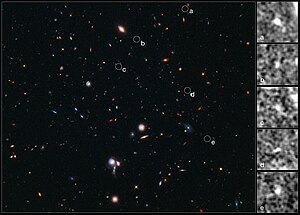
Back Sterrestelselswerm Afrikaans عنقود مجري Arabic Qalaktika topası Azerbaijani Галактикалар тупланмаһы Bashkir Скопішча галактык Byelorussian Галактическо струпване Bulgarian ছায়াপথ স্তবক Bengali/Bangla Galaktičko jato BS Cúmul de galàxies Catalan ھێشووی گەلەستێرەیی CKB

A galaxy cluster, or a cluster of galaxies, is a structure that consists of anywhere from hundreds to thousands of galaxies that are bound together by gravity,[1] with typical masses ranging from 1014 to 1015 solar masses. They are the second-largest known gravitationally bound structures in the universe after some superclusters (of which only one, the Shapley Supercluster, is known to be bound). They were believed to be the largest known structures in the universe until the 1980s, when superclusters were discovered.[2] One of the key features of clusters is the intracluster medium (ICM). The ICM consists of heated gas between the galaxies and has a peak temperature between 2–15 keV that is dependent on the total mass of the cluster. Galaxy clusters should not be confused with galactic clusters (also known as open clusters), which are star clusters within galaxies, or with globular clusters, which typically orbit galaxies. Small aggregates of galaxies are referred to as galaxy groups rather than clusters of galaxies. The galaxy groups and clusters can themselves cluster together to form superclusters.
Notable galaxy clusters in the relatively nearby Universe include the Virgo Cluster, Fornax Cluster, Hercules Cluster, and the Coma Cluster. A very large aggregation of galaxies known as the Great Attractor, dominated by the Norma Cluster, is massive enough to affect the local expansion of the Universe. Notable galaxy clusters in the distant, high-redshift universe include SPT-CL J0546-5345 and SPT-CL J2106-5844, the most massive galaxy clusters found in the early Universe. In the last few decades, they are also found to be relevant sites of particle acceleration, a feature that has been discovered by observing non-thermal diffuse radio emissions, such as radio halos and radio relics. Using the Chandra X-ray Observatory, structures such as cold fronts and shock waves have also been found in many galaxy clusters.
- ^ a b "Hubble Pinpoints Furthest Protocluster of Galaxies Ever Seen". ESA/Hubble Press Release. Retrieved 13 January 2012.
- ^ Kravtsov, A. V.; Borgani, S. (2012). "Formation of Galaxy Clusters". Annual Review of Astronomy and Astrophysics. 50: 353–409. arXiv:1205.5556. Bibcode:2012ARA&A..50..353K. doi:10.1146/annurev-astro-081811-125502. S2CID 119115331.